- The Birth of a Girl Who Heard God’s Voice
- The Liberation of Orléans: Joan’s Military Talent Blossoms
- The Coronation of Charles VII: Restoring the Legitimacy of the French Kingdom
- Capture and Trial: Joan’s Test of Faith
- Joan at the Stake: Martyrdom and the Birth of a Legend
- Rehabilitation and Sainthood: Joan’s Legacy
- The Modern Significance of Joan of Arc
- Conclusion: The Enduring Spirit of Joan of Arc
The Birth of a Girl Who Heard God’s Voice
In 1412, a girl was born in the village of Domrémy in eastern France. Her name was Joan of Arc. At that time, France was in the midst of the Hundred Years’ War with England, having lost most of its territory and facing a succession crisis. When Joan was 13, she claimed to have received a divine revelation while working in the garden. The voice, she said, commanded her to save France.
This event would later become a turning point in French history. Joan, convinced of her mission, took action despite opposition from those around her. Her determination was unwavering, and she would eventually lead the French army into battle.
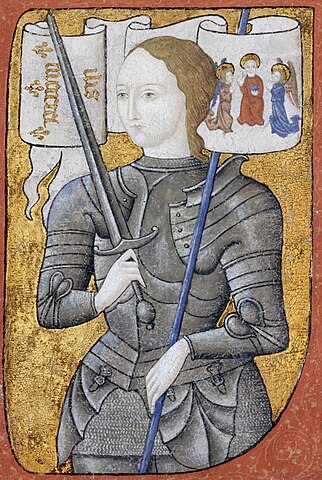
A 15th-century miniature of Joan of Arc, depicting her faith and determination. By Archives nationales
The Liberation of Orléans: Joan’s Military Talent Blossoms
In 1429, at the age of 17, Joan met with Charles VII at Chinon Castle. She persuaded the Dauphin that she was chosen by God and was given command of an army to lift the siege of Orléans.
The siege of Orléans was the greatest challenge for the French army at the time. The English had besieged this important city for over seven months, and French morale was at an all-time low. However, Joan’s arrival changed the situation dramatically.
She gave the army new hope and courage. The sight of Joan, clad in armor and riding a white horse, ignited the hearts of the soldiers. Her strategy was bold and effective, breaking through the English defense lines one after another.
In just nine days, Joan succeeded in liberating Orléans. This victory marked a turning point in the Hundred Years’ War and signaled the beginning of a French counteroffensive. It was here that Joan’s military talent first became known to the world.
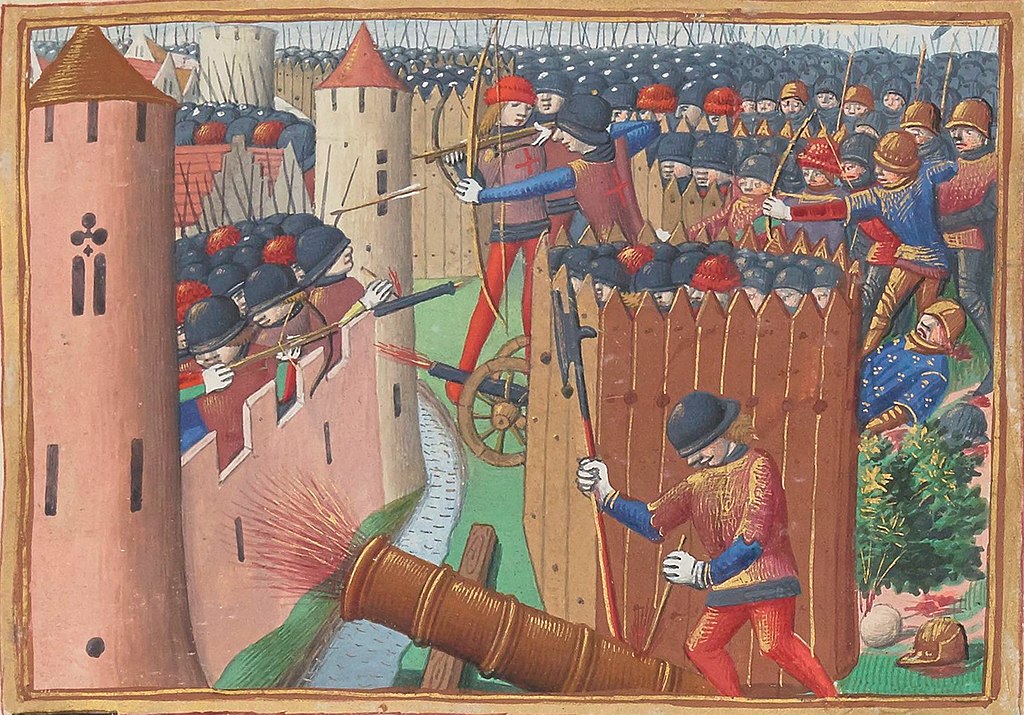
The siege of Orléans in 1429. The French army achieved victory thanks to Joan of Arc’s efforts. By Bibliothèque nationale de France
The Coronation of Charles VII: Restoring the Legitimacy of the French Kingdom
After the liberation of Orléans, Joan set her next goal: the coronation of Charles VII at Reims Cathedral. This was more than just a ceremony. At the time, Charles VII’s right to succession was in question, and an official coronation was essential to establish the legitimacy of his rule.
Joan marched through the Champagne region, which was under enemy control, and arrived in Reims on July 17. The following day, Charles VII was crowned in a splendid ceremony. This event played a significant role in uniting the French people and boosting their morale.
During the coronation, Joan stood by Charles VII’s side, holding her military standard. This scene symbolized her establishment as the savior of the French kingdom.
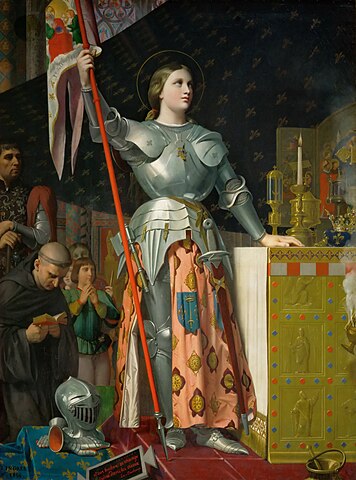
Jean-Auguste-Dominique Ingres’ ‘Joan of Arc at the Coronation of Charles VII,’ emphasizing Joan’s importance and symbolic role in the coronation. By Jean-Auguste-Dominique Ingres
Capture and Trial: Joan’s Test of Faith
However, Joan’s days of glory did not last long. In May 1430, she was captured by the Burgundian forces during the Battle of Compiègne and later handed over to the English. This marked the beginning of Joan’s most severe ordeal.
The trial held in Rouen had clear political intentions. The English side sought to condemn Joan as a heretic to demoralize the French. Although the trial was based on church law, the process lacked fairness.
Throughout the interrogation, Joan maintained her beliefs without wavering, continuing to assert the truth of her divine revelations. Her courage and faith impressed many people. However, she was ultimately found guilty of heresy.
Joan at the Stake: Martyrdom and the Birth of a Legend
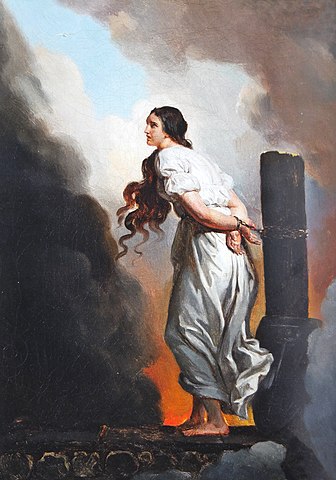
Alexandre-Évariste Fragonard’s ‘Joan of Arc at the Stake,’ dramatically depicting her martyrdom in Rouen on May 30, 1431. Joan’s faith and courage are vividly expressed. By Alexandre-Évariste Fragonard
On May 30, 1431, at the age of 19, Joan was burned at the stake in the marketplace of Rouen. Her last word is said to have been “Jesus.” This event shocked the French people.
Joan’s death elevated her to legendary status. Many people praised her courage, faith, and love for her country. Her story was widely spread through oral traditions and literature, becoming part of the French national identity.
Rehabilitation and Sainthood: Joan’s Legacy
After Joan’s death, France gradually turned the tide of war and eventually won the Hundred Years’ War. In 1456, by order of Charles VII, Joan’s case was retried, and she was found innocent. This rehabilitation greatly changed the perception of Joan.
Thereafter, Joan was long revered as a hero in the hearts of the French people. In the 19th century, with the rise of nationalism, her story once again gained attention.
In 1920, Joan was officially canonized as a saint by the Catholic Church. This recognition made her both a religious and public figure. Even today, May 30 is celebrated in France as “Joan of Arc Day.”
The Modern Significance of Joan of Arc
The story of Joan of Arc continues to influence many people across generations. She remains a symbol of courage, faith, and patriotism, and a source of pride for the French people.
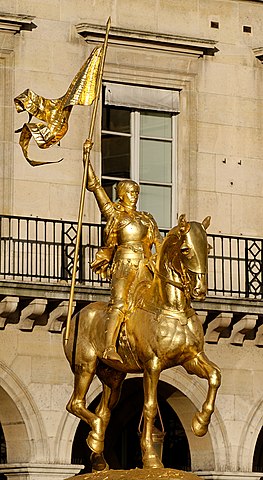
Emmanuel Frémiet’s equestrian statue of Joan of Arc in Paris. She is still revered as a national hero today. By Jastrow
Joan is also appreciated as a symbol of female power and potential. The fact that a young woman led armies into battle and changed the fate of a nation in a male-dominated medieval society provides a new perspective on contemporary gender equality discussions.
Furthermore, Joan’s story demonstrates that the power of belief and individual determination can move history. Her actions teach us the importance of maintaining hope even in difficult situations.
Conclusion: The Enduring Spirit of Joan of Arc
Joan of Arc’s short life had a profound impact not only on French history but also on world history. Her courage, faith, and love for her country are etched in the hearts of many people across time.
Today, Joan of Arc is not just a historical figure. She has become a symbol of courage in the face of adversity, strength in maintaining one’s convictions, and the power of an individual to change society. Her story continues to provide numerous insights for us as we face various challenges in modern society.


